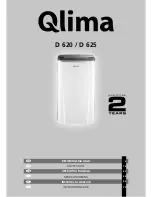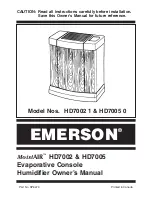
8
Version 2.2
ments. When wiping, take precautions against the poisonous vapours of cleaning fluids.
7. When carrying out installation and repair work, an information plate should be affixed
to the control panel to warn against unauthorised start-up. For example, “Do not turn on.
Personnel operating!”
8. The operator remotely controlling equipment must ensure that no installation or other
work is being performed with the equipment at that moment! An information plate must be
affixed to the equipment in relation to this: See 1.3.9.
9. Maintain cleanliness in the facility where the equipment is installed. Close open inlets
and outlets during installation with dry clothes or paper to prevent rubbish entering the
equipment.
10. Welding or other similar operations must not be carried out in the immediate vicinity of
the equipment and vessels under pressure.
11. If there is any suspicion of overheating, combustion or other emergency, turn off the
equipment. Immediately disconnect it from the power supply. Do not open the doors of
equipment until the temperature falls to room temperature, in order to prevent burns or injury.
12. Naked flames must not be used as a light source for inspecting and checking equipment.
13. Never use caustic solvents, which may damage materials of the pneumatic system
14. After performing installation or other work, ensure that no instruments, rags or spare
parts have been left inside the equipment.
15. Pay particular attention to the safety-relief valves. Thoroughly inspect them and remove
any dust and dirt. They must not be allowed to suffer any loss in function under any circum-
stances. Remember that your safety depends on their functionality!
16. Before beginning work in normal mode after maintenance or repair work, check that the
working pressure, temperature and other characteristics are correctly set. Ensure that all
control devices are installed and functioning properly.
17. When replacing filters, separators etc., wipe away dust, dirt and oil residue from the
area where they are installed with a dry cloth.
18. Protect the motor, air filter, electrical components and control components etc. from
coming into contact with condensate. For instance, blow down with dry air.
19. Safety precautions for operation with refrigerants:
• Never inhale refrigerant vapours. Ensure that the work zone is properly ventilated; use a
respirator if necessary;
• Always wear special-purpose gloves. If the refrigerant comes into contact with skin, rinse
the area of contact with plenty of water. If refrigerant comes into contact with skin through
clothing, do not try to remove clothing. Thoroughly rinse clothing with fresh water until the
refrigerant is washed off. Then seek medical assistance.
20. Use protective gloves during installation and repair work in order to avoid burns and
injury (for instance, during oil change).
Summary of Contents for 14310000
Page 52: ...52 2 2 1 1 1 1 2 1 2 3 Comprag 4 5...
Page 53: ...53 COMPRAG RDX 6 1 3 1 2 3 4 5 6 7 8 9...
Page 54: ...54 2 2 10 11 12 1 4 1 2 3...
Page 55: ...55 COMPRAG RDX 4 5 6 90 A 7 8 1 5...
Page 56: ...56 2 2 1 2 3 4 5 6 7 8 1 3 9 9 10 11 12 13 14 15 16...
Page 60: ...60 2 2 2 3 2 1 9 6 5 8 7 3 4 1 2 3 4 5 6 7 8 9 1 3 5 6 2 7 3 C...
Page 62: ...62 2 2 3 3 1 D H L 3 1 3 2...
Page 64: ...64 2 2 3 4...
Page 66: ...66 2 2 3 5 3 5 1 V 2 C RDX 04 77 5 M1 S1 M2 F1 A1 V1 S1 F...
Page 68: ...68 2 2 4 4 1 3 www comprag com RDX 3 2 1 4 1 1 V 2 RDX 04 18 1 2 3 3...
Page 71: ...71 COMPRAG RDX 1 2 4 1 4 V 2 1 2...
Page 72: ...72 2 2 4 2 8 1 2 4 1 1 4 1 2 4 1 3 4 3 4 3...
Page 73: ...73 COMPRAG RDX 1 2 3 4 3 1 2 3...
Page 74: ...74 2 2 5 5 1 R134a 2 2 0 1 0 R404a 5 4 0 1 0 5 1...
Page 75: ...75 COMPRAG RDX 5 2 1 2 3 5 2 1 2 3 2 3 1...
Page 76: ...76 2 2 6 6 1 30 4 1 5 3 1...
Page 77: ...77 COMPRAG RDX 5 3 5 3 4 3 5 3...
Page 78: ...78 2 2 7 7 1 10 25 85 7 2...
Page 79: ......
Page 80: ......








































